

Travel brings enlightenment and knowledge to both the traveller and cultures he encounters. Journey is a state of mind, both as function and metaphor, reflecting the traveller's inner search for belonging in times of change. With every new epiphany, the world changes. Rahul Gandhi's Bharat Jodo Yatra is part travel and part journey, the route to his own discovery of India. Or, held in the context of an upcoming opaque party election and unease over dynastic control, is it a cynical manoeuvre hoping for a pleasant outcome?
Political tours and travels are pathways of power on the map of ambition. Mahatma Gandhi elevated the padayatra to a fine art with the Dandi March and later during the Partition riots. LK Advani was the first cartographer of the post-Independence, Hindu nationalist psyche. In 1990, he steered the epic chariot of Ram through the first Hindutva highway along which Narendra Modi steered the BJP to triumph two decades later. Advani's Ekta Yatra in 1991 that came on the heels of his Ram Rath Yatra -- repeated by Murli Manohar Joshi in 2011 -- tested the leather of BJP's pan-India shoe print. The Janadesh Yatra in September 1993; then the Swarna Jayanti Rath Yatra in May 1997, paying homage to 50 years of Independence and last, the Bharat Suraksha Yatra in April 2006, were nationalist startups that foretold the great boom of 2014 -- the BJP was all along drafting the map of a new India while the Congress and its secular fellow travellers kept losing their way at the crossroads of appeasement and anarchy. In September 2002, Modi hit the road with his Gaurav Yatra after resigning as Gujarat's chief minister following the communal riots; it brought him a sweeping mandate by appealing to the "pride of the people of Gujarat".
From Gandhi to Modi and Rahul, re-discovery of India is the launch pad to the next level. In 1944, Jawaharlal Nehru wrote The Discovery of India from Ahmednagar Fort, where he was imprisoned between 1942 and 1945. He recollects travelling through the country, agitating against the British, and being greeted by crowds roaring 'Bharat Mata ki Jai!' He would ask them to explain who Bharat Mata is. People tried to define her geographically until Nehru's catechism wore them out. He writes, "The mountains and the rivers of India, and the forests and the broad fields, which gave us food, were all dear to us, but what counted ultimately were the people of India, people like them and me, who were spread out all over this vast land. Bharat Mata, Mother India, was essentially these millions of people, and victory to her meant victory to these people. You are parts of this Bharat Mata, I told them, you are in a manner yourselves Bharat Mata."
Nehru's great grandson is bound to realise on his yatra that Bharat Mata is greater than the sum of her parts. Nehru's Bharat Mata was an aggressive entity in the 1940s, at war with the coloniser and seeking freedom for the future. Modi's Bharat Mata is at war with its pluralistic present, seeking freedom from the past. Rahul must negotiate the ideological minefield that separates these two binaries to discover his own connection with her. Whatever be the outcome, his discovery of India is guaranteed to bring catharsis to both him and the Congress, which has warped the motherland idiom into a mother-and-son land starting with Indira Gandhi.
Ravi Shankar can be reached at ravi@newindianexpress.com.